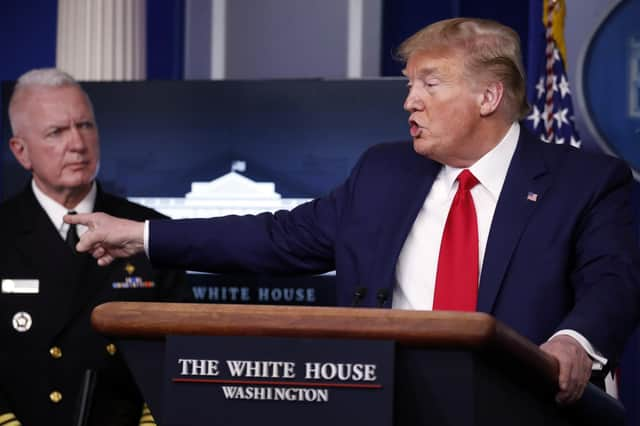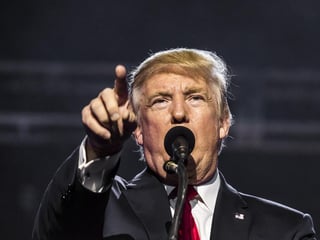Donald Trump is talking total tosh about WHO and Covid-19 coronavirus – Professor Hugh Pennington


So, Donald Trump has withdrawn US funding from the World Health Organisation. Its $400 million contribution amounts to 10 to 15 per cent of the WHO’s annual budget, a big loss at any time but particularly so at a time of crisis.
The only softening of the blow is that the US is said to be behind in its payments. Trump’s reasons for his decision are that the WHO was slow to raise the alarm about the new coronavirus and that the organisation is too “China-centric”.
Advertisement
Hide AdAdvertisement
Hide AdTotal tosh. The first hospitalised Covid-19 cases were spotted in Hubei province in late December 2019. At the end of the month, a patient with unusual pneumonia had a very unpleasant invasive test to get samples from deep in the lungs. The sample was tested for coronaviruses related to Sars using a molecular procedure. It was positive. Genome sequencing showed that it was not Sars but a virus related to a bat coronavirus.
It was grown in the lab and electron microscopy revealed viruses with the knobbed spikes with which we are now only too familiar. It caused pneumonia in mice with human genes. The genome sequence was published on 12 January using the Global Initiative on Sharing All Influenza Data, and tests were designed using this information within 24 hours.
Wuhan, a metropolis bigger than London, was closed down on 23 January. My test for the speed of response to the appearance of this brand new virus is whether we would have done it faster in the UK if the virus had developed here; not a hypothetical but a real question. Coronaviruses that might swap genes with our common cold coronaviruses occur in mice and birds; the puffinosis virus that occurs in Manx shearwaters, gulls and fulmars in Wales and the Northern Isles is probably another example.
‘American exceptionalism’
My guess is that, on balance, we would have taken longer, that the same conclusion holds for the US, and that China moved with expedition and speed because they feared a return of Sars, and a repeat of the embarrassment they suffered with that virus. It first appeared in November 2002, with the WHO not being notified until February 2003, when it played a blinder in bringing together scientists from Hong Kong, Germany and Atlanta in the US, persuading them to put their pride to one side as well as the desire universally felt by researchers to be acknowledged as the first to make a discovery, and instead to collaborate to identify the new virus, which they did.
Although the WHO was founded as part of the United Nations after the Second World War, it had a precursor, the League of Nations Health Organisation. Like the WHO today, it was located in Geneva. It worked on world health problems, a good example being the standardisation of tests for infectious diseases, particularly syphilis, a lethal scourge in the days before penicillin.
But the US didn’t take part, because it wasn’t a member of the League. Although invented by Woodrow Wilson, the US president, for which he won the Nobel Peace Prize in 1919, the Senate had voted against US membership. So Trump is only following history in declining to support an international organisation and asserting American exceptionalism, “America first”, “God’s own country”, and all his other nationalistic tropes.
The WHO’s director-generals have a difficult furrow to plough. They are criticised for acting too soon, and acting too late. In 2009, Margaret Chan declared a flu pandemic. It spread worldwide, so it was, but she was accused of “crying wolf”.
Planning for pandemics
Much publicity attended the statements of Wolfgang Wodarg, the chair of the Council of Europe health committee, that it was a “fake” pandemic, words reminiscent of some of Trump’s sayings.
Advertisement
Hide AdAdvertisement
Hide AdBut Wodarg had misunderstood the meaning of the term ‘pandemic’; it describes the extent of spread of a disease, not its severity.
As it happened, the pandemic was caused by a flu virus with low virulence. It illustrates very well the problems facing planners for the next pandemic.
Before the 2009 virus arrived in the UK, our plan predicted the possible slow spread from China of a virus that would kill between 55,000 and 750,000. But it came quickly from Mexico and killed 457.
Hiroshi Nakajima was WHO director-general from 1988 until 1998. I visited the WHO Geneva headquarters towards the end of his stint, which was not always a happy one. He had fallen out, for example, with Jonathan Mann, head of the WHO Global Programme on Aids, about how the problem should be addressed.
With the benefit of hindsight both were right – it was a very important social problem, as well as one that might be solved by science. My trip in 1997 was to take part in an international WHO Consultation on the Prevention and Control of Enterohaemorrhagic Escherichia coli Infections.
It is worth remembering that, before we point the finger at China as the common source of new nasty microbes, we should remember that E. coli O157 only appeared for the first time early in the 1980s, that it may well have evolved on the Argentinian pampas, that it went on in the strict sense to cause an asymptomatic pandemic in ruminant animals (it occurs in all continents and is carried by the animals without causing disease), and that today, human disease caused by it is commoner in Scotland than anywhere else.
After testing, a big and important agenda item for our meeting was the prevention of infection in nursing homes. We already knew that they were places inhabited by very susceptible people between which infectious diseases could spread with alacrity. Dementia expunges memories of good hygiene habits and age is the most important risk factor for infections to have an unhappy outcome. A common newspaper headline in winters past had been “mystery killer virus strikes care home”.
The virus was no mystery. It was flu. Now it is Covid-19. Protecting care home residents requires at least two things, the frequent regular testing of staff (it is known that many individuals who spread the disease have no symptoms) and PPE for them.
Advertisement
Hide AdAdvertisement
Hide AdWithout progress on both, I fear that tragedies will continue.
Hugh Pennington is emeritus professor of bacteriology at the University of Aberdeen
A message from the Editor:
Thank you for reading this article on our website. While I have your attention, I also have an important request to make of you.
With the coronavirus lockdown having a major impact on many of our advertisers - and consequently the revenue we receive - we are more reliant than ever on you taking out a digital subscription.
Subscribe to scotsman.com and enjoy unlimited access to Scottish news and information online and on our app. With a digital subscription, you can read more than 5 articles, see fewer ads, enjoy faster load times, and get access to exclusive newsletters and content. Visit www.scotsman.com/subscriptions now to sign up.
Our journalism costs money and we rely on advertising, print and digital revenues to help to support them. By supporting us, we are able to support you in providing trusted, fact-checked content for this website.
Frank O’Donnell
Editorial Director
Comments
Want to join the conversation? Please or to comment on this article.
